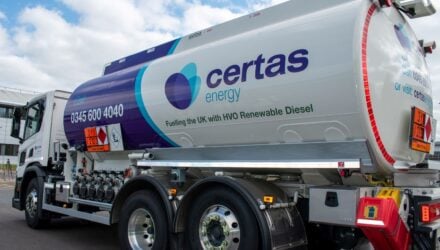The widespread use of high blend renewable fuels (HBRF) could reduce truck emissions by 46 million tonnes over the next decade, a study by Zemo Partnership has found.
 The Government has announced the introduction of E10 petrol into the UK and the organisation says even greater greenhouse gas savings could be realised with an aggressive policy framework for HBRF in heavy duty vehicles currently running on diesel and natural gas.
The Government has announced the introduction of E10 petrol into the UK and the organisation says even greater greenhouse gas savings could be realised with an aggressive policy framework for HBRF in heavy duty vehicles currently running on diesel and natural gas.
The organisation, which will soon launch its Renewable Fuels Assurance Scheme and declaration certificate, says the use of HBRF is particularly effective and has the greatest potential in heavier and long-haul applications which will also be the most difficult to electrify in the short term.
Gloria Esposito, Zemo Partnership’s head of sustainability, said: “We’re now on a trajectory for net zero emissions transport by 2050, but our impact on the climate is what matters and action in this area can accelerate GHG emissions cuts over the next 30 years.
“If we can decarbonise the fuels we’ll be using until we can achieve full electrification across the vehicle fleet, we can minimise the impact of emissions from road transport on our way to zero.”
Zemo Partnership’s new HBRF study says there are significant opportunities for sustainable, renewable fuel adoption by heavy duty vehicles and, in particular, trucks and coaches which are currently responsible for around 5% of the UK’s total GHG emissions.
The study showed that with a market average of 30% HBRF, used in place of fossil fuels (diesel and natural gas) by 2030, the sector could save an additional 46m tonnes in GHG emissions over the next decade, with savings continuing to 2050.
The biggest opportunities are in the heaviest vehicles with the longest journey profiles, which also produce the most GHG emissions.
The report covers renewable fuels including biodiesel, hydrotreated vegetable oil and biomethane, identifying the barriers to adoption and the GHG-saving opportunities available from HBRF to support different rates of electrification in these fleets.
High blend biodiesel has already made good inroads in the bus market while both biomethane and HVO adoption in HGV fleets have shown encouraging recent increases, driven partly by requirements for carbon reporting and GHG emissions improvements.


















